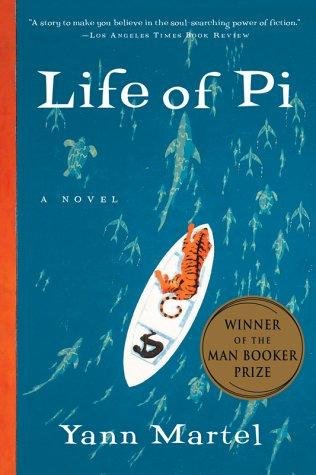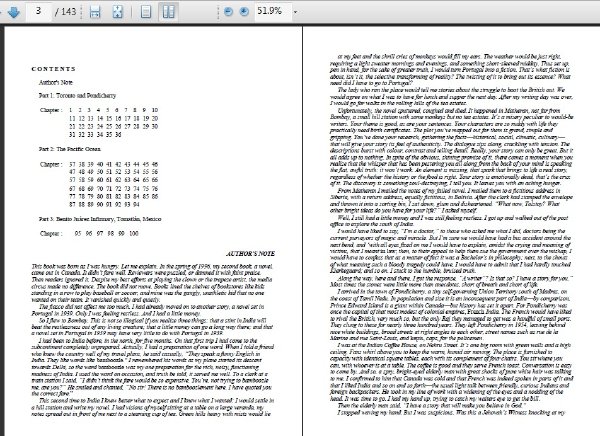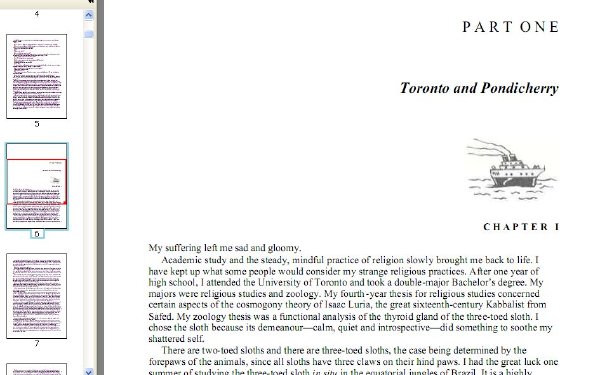《少年Pi的奇幻漂流》(Life of Pi )(Yann Martel)英文文字版[PDF] 簡介: 中文名 : 少年Pi的奇幻漂流 原名 : Life of Pi 作者 : Yann Martel 資源格式 : PDF 版本 : 英文文字版 出版社 : Harvest Books 書號 : 9780156027328 發行時間 : 2003年05月01日 地區 : 加拿大 語言 : 英文 簡介 : 內容簡介 本書獲2002年度英國布克獎;被評為亞馬遜網站2
"《少年Pi的奇幻漂流》(Life of Pi )(Yann Martel)英文文字版[PDF]"介紹
中文名: 少年Pi的奇幻漂流
原名: Life of Pi
作者: Yann Martel
資源格式: PDF
版本: 英文文字版
出版社: Harvest Books
書號: 9780156027328
發行時間: 2003年05月01日
地區: 加拿大
語言: 英文
簡介:

內容簡介
本書獲2002年度英國布克獎;被評為亞馬遜網站2002年度最佳圖書、《紐約時報》年度傑出圖書、《出版家周刊》年度最佳圖書、《洛杉矶時報》年度最佳小說;2004年又獲德國圖書獎。
無論從什麼方面來看,本書都是一部奇特的小說。它是一個扣人心弦的歷險故事,一個關於人類在宇宙中的位置的寓言,一部引人入勝的超小說……機智使它更有活力,恐怖為它增添了趣味,它是一位不同尋常的天才的作品。
我不能說這部小說是一部偉大的文學作品,馬特爾也稱不上是一位偉大的作家,但他卻是一個講故事的高手。小說的開篇序言亦真亦假,以第一人稱敘述,講述的基本上是馬特爾自己的經歷:第一本小說出版後如石牛入水,只賣出幾百本後就無人問津;第二部小說剛剛開頭就文思枯竭,於是,作者離開加拿大前往印度尋找靈感。他在喜馬拉雅山下的咖啡館中遇到一人,此位印度智者說:“我有一個故事,這個故事可以讓你相信上帝。”接著此人介紹了一位他們家的世交,現住加拿大的帕特爾。作者回到加拿大,找到帕特爾,聽帕特爾講述他一生的故事,於是,形成此書。
小說第一部分寫的是“作者”在加拿大采訪帕特爾,帕特爾對於他少年時代在印度生活的回憶,他的父母、哥哥以及叔伯親戚,他的學校老師以及家庭的朋友,他們家的動物園中的各種動物。在加拿大,每次書中的“我“去采訪他,總是逐漸發現帕特爾的一些私人生活,先是發現他並不是孤身一人,他有一位妻子;然後又發現他還有一個十來歲的兒子,采訪將近結束時,人們意識到帕特爾還有一位可愛的四歲的女兒。“我”頗為感慨:“至少,這個故事有一個幸福的結局。”但是這第一部分中很大一部分文字,都讓人覺得冗長乏味。值得一提的是帕特爾的名字,他大號派西尼·莫利托·帕特爾(PiscineMolitorPatel),是取法國巴黎一家游泳池之名,但是Piscine與英文小便同音,於是帕特爾從小在學校中就常常遭到同學取笑,於是,他決定把自己的名字簡化成Pi,自以為是酷名字。
閱讀這部小說的最好忠告,是耐心,等到小說的第一部分收了尾,帕特爾的父親決定全家帶著動物移民加拿大,他們所乘坐的日本貨船漂蕩在太平洋上時,馬特爾的敘述就充滿了你無法拒絕不能釋手的魅力。
日本貨輪失事,帕特爾被兩名水手當做誘餌扔到救生艇中去喂鬣狗,他僥幸落在救生艇的艙蓋布上得以生存,於是,他開始了在海上漂泊227天的歷程,與他同時處在救生艇中的,除了那只鬣狗外,還有一只斷了一條腿的斑馬、一只猩猩以及一只成年孟加拉虎,由於海關官員的失誤,這只孟加拉虎注冊了一個正兒八經的紳士的名字:理查德·帕克。在救生艇上的最初三天,鬣狗咬死了猩猩,活吃了斑馬,理查德·帕克咬死了鬣狗。接著,16歲的少年帕特爾海上生存的故事,就是如何對付理查德·帕克的故事。
一開始,帕特爾滿腦子想的是如何把老虎置於死地,奪回他在救生艇上的生存空間,他想了六種對付老虎的計策,第一,把它推下救生艇;第二,用救生艇儲藏室中的六針嗎啡把它置於死地;第三,用所有能弄到手的武器來攻擊它;第四,用東西把它噎死;第五,給它下毒,在它身上放火,電死它;第六,與它打消耗戰。然而,仔細考慮後,這六點都沒有用。帕特爾意識到,如果和理查德·帕克斗爭,輸的只是他自己;他注意到,老虎在海浪平靜吃飽了救生艇上的動物殘骸之後,竟然如同一只可愛的大貓一樣向他表示友善。最後,帕特爾得出結論,他的生路只有一條,那就是要保證理查德·帕克的食物和飲水,只要老虎不餓,他就沒有危險。帕特爾從救生艇儲藏室中找出釣竿,取出海水淡化器,這位生來素食長大的少年開始成為海上垂釣解剖海龜和大小魚類的能手。此外,帕特爾還根據他從小在動物園中長大所積累的經驗,開始了馴虎的過程,他一是利用老虎暈船的短處,二是讓老虎明白,他是食物和水的來源,他甚至通過把玩理查德·帕克的糞便來打敗老虎耀武揚威的士氣,逐漸,理查德·帕克終於明白了在救生艇中帕特爾是老大,他是老二。馬特爾關於馴虎的描繪經過最細致的調查研究,讀後讓你油然而生想當馬戲團馴獸員的欲望。更重要的是,這馴虎的過程也是少年帕特爾演變成成年男人的過程。
作者簡介

揚·馬特爾(Yann Martel),加拿大作家,1963年出生於西班牙,父母是加拿大人。他要哥斯達黎加、法國、墨西哥和加拿大長大。大學哲學系畢業後,他做過洗碗工、植樹工和保安。之後他開始寫作。當他不住在別處的時候,就住在蒙特利爾。
★NOMINEE 2001 - Governor General's Literary Award
★WINNER 2001 - Hugh MacLennan Prize
★WINNER 2002 - Booker Prize
★NOMINEE 2001 - Commonwealth Writers Prize for Best Book
"Life of Pi is a terrific book.It's fresh,original,smart,devious,and crammed with abosorbing lore." --MARGARET ATWOOD
Life of Pi is a masterful and utterly original novel that is at once the story of a young castaway who faces immeasurable hardships on the high seas, and a meditation on religion, faith, art and life that is as witty as it is profound. Using the threads of all of our best stories, Yann Martel has woven a glorious spiritual adventure that makes us question what it means to be alive, and to believe.
Growing up in Pondicherry, India, Piscine Molitor Patel -- known as Pi -- has a rich life. Bookish by nature, young Pi acquires a broad knowledge of not only the great religious texts but of all literature, and has a great curiosity about how the world works. His family runs the local zoo, and he spends many of his days among goats, hippos, swans, and bears, developing his own theories about the nature of animals and how human nature conforms to it. Pi’s family life is quite happy, even though his brother picks on him and his parents aren’t quite sure how to accept his decision to simultaneously embrace and practise three religions -- Christianity, Hinduism, and Islam.
But despite the lush and nurturing variety of Pi’s world, there are broad political changes afoot in India, and when Pi is sixteen his parents decide that the family needs to escape to a better life. Choosing to move to Canada, they close the zoo, pack their belongings, and board a Japanese cargo ship called the Tsimtsum. Travelling with them are many of their animals, bound for zoos in North America. However, they have only just begun their journey when the ship sinks, taking the dreams of the Patel family down with it. Only Pi survives, cast adrift in a lifeboat with the unlikeliest of travelling companions: a zebra, an orang-utan, a hyena, and a 450-pound Royal Bengal tiger named Richard Parker.
Thus begins Pi Patel’s epic, 227-day voyage across the Pacific, and the powerful story of faith and survival at the heart of Life of Pi. Worn and scared, oscillating between hope and despair, Pi is witness to the playing out of the food chain, quite aware of his new position within it. When only the tiger is left of the seafaring menagerie, Pi realizes that his survival depends on his ability to assert his own will, and sets upon a grand and ordered scheme to keep from being Richard Parker’s next meal.
As the days pass, Pi fights both boredom and terror by throwing himself into the practical details of surviving on the open sea -- catching fish, collecting rain water, protecting himself from the sun -- all the while ensuring that the tiger is also kept alive, and knows that Pi is the key to his survival. The castaways face gruelling pain in their brushes with starvation, illness, and the storms that lash the small boat, but there is also the solace of beauty: the rainbow hues of a dorado’s death-throes, the peaceful eye of a looming whale, the shimmering blues of the ocean’s swells. Hope is fleeting, however, and despite adapting his religious practices to his daily routine, Pi feels the constant, pressing weight of despair. It is during the most hopeless and gruelling days of his voyage that Pi whittles to the core of his beliefs, casts off his own assumptions, and faces his underlying terrors head-on.
As Yann Martel has said in one interview, “The theme of this novel can be summarized in three lines. Life is a story. You can choose your story. And a story with an imaginative overlay is the better story.” And for Martel, the greatest imaginative overlay is religion. “God is a shorthand for anything that is beyond the material -- any greater pattern of meaning.” In Life of Pi, the question of stories, and of what stories to believe, is front and centre from the beginning, when the author tells us how he was led to Pi Patel and to this novel: in an Indian coffee house, a gentleman told him, “I have a story that will make you believe in God.” And as this novel comes to its brilliant conclusion, Pi shows us that the story with the imaginative overlay is also the story that contains the most truth.
--------------------------------------------------------------------------------
作者簡介
Yann Martel was born in Spain in 1963 of peripatetic Canadian parents. He grew up in Alaska, British Columbia, Costa Rica, France, Ontario and Mexico, and has continued travelling as an adult, spending time in Iran, Turkey and India. After studying philosophy at Trent University and while doing various odd jobs -- tree planting, dishwashing, working as a security guard -- he began to write. He is the prize-winning author of The Facts Behind the Helsinki Roccamatios, a collection of short stories, and of Self, a novel, both of them published internationally.
He has been living from his writing since the age of 27. He divides his time between yoga, writing and volunteering in a palliative care unit. Yann Martel lives in Montreal.
With over 1250 reviews already registered for LIFE OF PI, I first thought there could be nothing more to say about this marvelous novel. But after scanning the most recent 100 reviews, I began to wonder what book many of those reviewers had read. Had I relied on 98 of those reviews, I would have expected a far different book than the one I actually read.
Let's begin with what LIFE OF PI isn't. It's not a Man against Nature survival story. It's not a story about zoos or wild animals or animal husbandry. It's not ROBINSON CRUSOE or SWISS FAMILY ROBINSON. It's not a literary version of CASTAWAY or OPEN WATER, and it's not a "triumph against all odds, happily ever after" rescue story. To classify it as such would be like classifying THE OLD MAN AND THE SEA as a story about a poor fisherman or MOBY DICK as a sea story. Or THE TRIAL as a courtroom drama, THE PLAGUE as a story of an epidemic, HEART OF DARKNESS as a story about slavery, or ANIMAL FARM as an animal adventure.
Martel's story line is already well-known: a fifteen-year-old boy, the son of a zookeeper in Pondicherry, India survives a shipwreck several days out of Manila. He is the lone human survivor, but his lifeboat is occupied by a Bengal tiger named Richard Parker, an injured zebra, a hyena, and an orangutan. In relatively short order and true Darwinian fashion, their numbers are reduced to just two: the boy Piscene Molitor Patel, and the tiger, Richard Parker. By dint of his zoo exposure and a fortuitously positioned tarpaulin, Pi (as he is called) manages to establish his own territory on the lifeboat and even gains alpha dominance over Richard Parker. At various points in their 227-day ordeal, Pi and the tiger miss being rescued by an oil tanker, meet up with another shipwreck survivor, and discover an extraordinary algae island before finally reaching safety.
When Pi retells the entire story to two representatives of the Japanese Ministry of Transport searching for the cause of the sinking, they express deep disbelief, so he offers them a second, far more mundane but believable story that parallels the first one. They can choose to believe the more fantastical first one despite its seeming irrationality (Pi is, after all, an irrational number) and its necessary leap of faith, or they can accept the second, far more rational version, more heavily grounded in our everyday experiences.
LIFE OF PI is an allegory, the symbolic expression of a deeper meaning through a tale acted out by humans, animals, and in this case, even plant life. Yann Martel has crafted a magnificently unlikely tale involving zoology and botany, religious experience, and ocean survival skills to explore the meaning of stories in our lives, whether they are inspired by religion to explain the purpose of life or generated by our own psyches as a way to understand and interpret the world around us.
Martel employs a number of religious themes and devices to introduce religion as one of mankind's primary filters for interpreting reality. Pi's active adoption and participation in Hinduism, Islam, and Christianity establish him as a character able to relate his story through the lens of the world's three major religions. Prayer and religious references abound, and his adventures bring to mind such Old Testament scenes as the Garden of Eden, Daniel and the lion's den, the trials of Job, and even Jonah and the whale. Accepting Pi's survival story as true, without supporting evidence, is little different than accepting New Testament stories about Jesus. They are matters of faith, not empiricism.
In the end, however, LIFE OF PI takes a broader view. All people are storytellers, casting their experiences and even their own life events in story form. Martel's message is that all humans use stories to process the reality around them, from the stories that comprise history to those that explain the actions and behaviors of our families and friends. We could never process the chaotic stream of events from everyday life without stories to help us categorize and compartmentalize them. Yet we all choose our own stories to accomplish this - some based on faith and religion, some based on empiricism and science. The approach we choose dictates our interpretation of the world around us.
LIFE OF PI bears a faint resemblance to the movie BIG FISH, also a story about storytelling and how we understand and rationalize our own lives through tales both mundane and tall. Martel's book is structured as a story within a story within a story, planned and executed in precisely 100 chapters as a mathematical counterpoint to the endlessly irrational and nonrepeating value of pi. The book is alternately harrowing and amusing, deeply rational and scientific but wildly mystical and improbable. It is also hugely entertaining and highly readable, as fluid as the water in which Pi floats. Anyone who enjoys literature as a vehicle for contemplating the human condition should find in LIFE OF PI a delicious treat.
內容截圖


目錄:
author's note
part 1
part 2
part 3
原名: Life of Pi
作者: Yann Martel
資源格式: PDF
版本: 英文文字版
出版社: Harvest Books
書號: 9780156027328
發行時間: 2003年05月01日
地區: 加拿大
語言: 英文
簡介:

內容簡介
本書獲2002年度英國布克獎;被評為亞馬遜網站2002年度最佳圖書、《紐約時報》年度傑出圖書、《出版家周刊》年度最佳圖書、《洛杉矶時報》年度最佳小說;2004年又獲德國圖書獎。
無論從什麼方面來看,本書都是一部奇特的小說。它是一個扣人心弦的歷險故事,一個關於人類在宇宙中的位置的寓言,一部引人入勝的超小說……機智使它更有活力,恐怖為它增添了趣味,它是一位不同尋常的天才的作品。
我不能說這部小說是一部偉大的文學作品,馬特爾也稱不上是一位偉大的作家,但他卻是一個講故事的高手。小說的開篇序言亦真亦假,以第一人稱敘述,講述的基本上是馬特爾自己的經歷:第一本小說出版後如石牛入水,只賣出幾百本後就無人問津;第二部小說剛剛開頭就文思枯竭,於是,作者離開加拿大前往印度尋找靈感。他在喜馬拉雅山下的咖啡館中遇到一人,此位印度智者說:“我有一個故事,這個故事可以讓你相信上帝。”接著此人介紹了一位他們家的世交,現住加拿大的帕特爾。作者回到加拿大,找到帕特爾,聽帕特爾講述他一生的故事,於是,形成此書。
小說第一部分寫的是“作者”在加拿大采訪帕特爾,帕特爾對於他少年時代在印度生活的回憶,他的父母、哥哥以及叔伯親戚,他的學校老師以及家庭的朋友,他們家的動物園中的各種動物。在加拿大,每次書中的“我“去采訪他,總是逐漸發現帕特爾的一些私人生活,先是發現他並不是孤身一人,他有一位妻子;然後又發現他還有一個十來歲的兒子,采訪將近結束時,人們意識到帕特爾還有一位可愛的四歲的女兒。“我”頗為感慨:“至少,這個故事有一個幸福的結局。”但是這第一部分中很大一部分文字,都讓人覺得冗長乏味。值得一提的是帕特爾的名字,他大號派西尼·莫利托·帕特爾(PiscineMolitorPatel),是取法國巴黎一家游泳池之名,但是Piscine與英文小便同音,於是帕特爾從小在學校中就常常遭到同學取笑,於是,他決定把自己的名字簡化成Pi,自以為是酷名字。
閱讀這部小說的最好忠告,是耐心,等到小說的第一部分收了尾,帕特爾的父親決定全家帶著動物移民加拿大,他們所乘坐的日本貨船漂蕩在太平洋上時,馬特爾的敘述就充滿了你無法拒絕不能釋手的魅力。
日本貨輪失事,帕特爾被兩名水手當做誘餌扔到救生艇中去喂鬣狗,他僥幸落在救生艇的艙蓋布上得以生存,於是,他開始了在海上漂泊227天的歷程,與他同時處在救生艇中的,除了那只鬣狗外,還有一只斷了一條腿的斑馬、一只猩猩以及一只成年孟加拉虎,由於海關官員的失誤,這只孟加拉虎注冊了一個正兒八經的紳士的名字:理查德·帕克。在救生艇上的最初三天,鬣狗咬死了猩猩,活吃了斑馬,理查德·帕克咬死了鬣狗。接著,16歲的少年帕特爾海上生存的故事,就是如何對付理查德·帕克的故事。
一開始,帕特爾滿腦子想的是如何把老虎置於死地,奪回他在救生艇上的生存空間,他想了六種對付老虎的計策,第一,把它推下救生艇;第二,用救生艇儲藏室中的六針嗎啡把它置於死地;第三,用所有能弄到手的武器來攻擊它;第四,用東西把它噎死;第五,給它下毒,在它身上放火,電死它;第六,與它打消耗戰。然而,仔細考慮後,這六點都沒有用。帕特爾意識到,如果和理查德·帕克斗爭,輸的只是他自己;他注意到,老虎在海浪平靜吃飽了救生艇上的動物殘骸之後,竟然如同一只可愛的大貓一樣向他表示友善。最後,帕特爾得出結論,他的生路只有一條,那就是要保證理查德·帕克的食物和飲水,只要老虎不餓,他就沒有危險。帕特爾從救生艇儲藏室中找出釣竿,取出海水淡化器,這位生來素食長大的少年開始成為海上垂釣解剖海龜和大小魚類的能手。此外,帕特爾還根據他從小在動物園中長大所積累的經驗,開始了馴虎的過程,他一是利用老虎暈船的短處,二是讓老虎明白,他是食物和水的來源,他甚至通過把玩理查德·帕克的糞便來打敗老虎耀武揚威的士氣,逐漸,理查德·帕克終於明白了在救生艇中帕特爾是老大,他是老二。馬特爾關於馴虎的描繪經過最細致的調查研究,讀後讓你油然而生想當馬戲團馴獸員的欲望。更重要的是,這馴虎的過程也是少年帕特爾演變成成年男人的過程。
作者簡介

揚·馬特爾(Yann Martel),加拿大作家,1963年出生於西班牙,父母是加拿大人。他要哥斯達黎加、法國、墨西哥和加拿大長大。大學哲學系畢業後,他做過洗碗工、植樹工和保安。之後他開始寫作。當他不住在別處的時候,就住在蒙特利爾。
★NOMINEE 2001 - Governor General's Literary Award
★WINNER 2001 - Hugh MacLennan Prize
★WINNER 2002 - Booker Prize
★NOMINEE 2001 - Commonwealth Writers Prize for Best Book
"Life of Pi is a terrific book.It's fresh,original,smart,devious,and crammed with abosorbing lore." --MARGARET ATWOOD
Life of Pi is a masterful and utterly original novel that is at once the story of a young castaway who faces immeasurable hardships on the high seas, and a meditation on religion, faith, art and life that is as witty as it is profound. Using the threads of all of our best stories, Yann Martel has woven a glorious spiritual adventure that makes us question what it means to be alive, and to believe.
Growing up in Pondicherry, India, Piscine Molitor Patel -- known as Pi -- has a rich life. Bookish by nature, young Pi acquires a broad knowledge of not only the great religious texts but of all literature, and has a great curiosity about how the world works. His family runs the local zoo, and he spends many of his days among goats, hippos, swans, and bears, developing his own theories about the nature of animals and how human nature conforms to it. Pi’s family life is quite happy, even though his brother picks on him and his parents aren’t quite sure how to accept his decision to simultaneously embrace and practise three religions -- Christianity, Hinduism, and Islam.
But despite the lush and nurturing variety of Pi’s world, there are broad political changes afoot in India, and when Pi is sixteen his parents decide that the family needs to escape to a better life. Choosing to move to Canada, they close the zoo, pack their belongings, and board a Japanese cargo ship called the Tsimtsum. Travelling with them are many of their animals, bound for zoos in North America. However, they have only just begun their journey when the ship sinks, taking the dreams of the Patel family down with it. Only Pi survives, cast adrift in a lifeboat with the unlikeliest of travelling companions: a zebra, an orang-utan, a hyena, and a 450-pound Royal Bengal tiger named Richard Parker.
Thus begins Pi Patel’s epic, 227-day voyage across the Pacific, and the powerful story of faith and survival at the heart of Life of Pi. Worn and scared, oscillating between hope and despair, Pi is witness to the playing out of the food chain, quite aware of his new position within it. When only the tiger is left of the seafaring menagerie, Pi realizes that his survival depends on his ability to assert his own will, and sets upon a grand and ordered scheme to keep from being Richard Parker’s next meal.
As the days pass, Pi fights both boredom and terror by throwing himself into the practical details of surviving on the open sea -- catching fish, collecting rain water, protecting himself from the sun -- all the while ensuring that the tiger is also kept alive, and knows that Pi is the key to his survival. The castaways face gruelling pain in their brushes with starvation, illness, and the storms that lash the small boat, but there is also the solace of beauty: the rainbow hues of a dorado’s death-throes, the peaceful eye of a looming whale, the shimmering blues of the ocean’s swells. Hope is fleeting, however, and despite adapting his religious practices to his daily routine, Pi feels the constant, pressing weight of despair. It is during the most hopeless and gruelling days of his voyage that Pi whittles to the core of his beliefs, casts off his own assumptions, and faces his underlying terrors head-on.
As Yann Martel has said in one interview, “The theme of this novel can be summarized in three lines. Life is a story. You can choose your story. And a story with an imaginative overlay is the better story.” And for Martel, the greatest imaginative overlay is religion. “God is a shorthand for anything that is beyond the material -- any greater pattern of meaning.” In Life of Pi, the question of stories, and of what stories to believe, is front and centre from the beginning, when the author tells us how he was led to Pi Patel and to this novel: in an Indian coffee house, a gentleman told him, “I have a story that will make you believe in God.” And as this novel comes to its brilliant conclusion, Pi shows us that the story with the imaginative overlay is also the story that contains the most truth.
--------------------------------------------------------------------------------
作者簡介
Yann Martel was born in Spain in 1963 of peripatetic Canadian parents. He grew up in Alaska, British Columbia, Costa Rica, France, Ontario and Mexico, and has continued travelling as an adult, spending time in Iran, Turkey and India. After studying philosophy at Trent University and while doing various odd jobs -- tree planting, dishwashing, working as a security guard -- he began to write. He is the prize-winning author of The Facts Behind the Helsinki Roccamatios, a collection of short stories, and of Self, a novel, both of them published internationally.
He has been living from his writing since the age of 27. He divides his time between yoga, writing and volunteering in a palliative care unit. Yann Martel lives in Montreal.
With over 1250 reviews already registered for LIFE OF PI, I first thought there could be nothing more to say about this marvelous novel. But after scanning the most recent 100 reviews, I began to wonder what book many of those reviewers had read. Had I relied on 98 of those reviews, I would have expected a far different book than the one I actually read.
Let's begin with what LIFE OF PI isn't. It's not a Man against Nature survival story. It's not a story about zoos or wild animals or animal husbandry. It's not ROBINSON CRUSOE or SWISS FAMILY ROBINSON. It's not a literary version of CASTAWAY or OPEN WATER, and it's not a "triumph against all odds, happily ever after" rescue story. To classify it as such would be like classifying THE OLD MAN AND THE SEA as a story about a poor fisherman or MOBY DICK as a sea story. Or THE TRIAL as a courtroom drama, THE PLAGUE as a story of an epidemic, HEART OF DARKNESS as a story about slavery, or ANIMAL FARM as an animal adventure.
Martel's story line is already well-known: a fifteen-year-old boy, the son of a zookeeper in Pondicherry, India survives a shipwreck several days out of Manila. He is the lone human survivor, but his lifeboat is occupied by a Bengal tiger named Richard Parker, an injured zebra, a hyena, and an orangutan. In relatively short order and true Darwinian fashion, their numbers are reduced to just two: the boy Piscene Molitor Patel, and the tiger, Richard Parker. By dint of his zoo exposure and a fortuitously positioned tarpaulin, Pi (as he is called) manages to establish his own territory on the lifeboat and even gains alpha dominance over Richard Parker. At various points in their 227-day ordeal, Pi and the tiger miss being rescued by an oil tanker, meet up with another shipwreck survivor, and discover an extraordinary algae island before finally reaching safety.
When Pi retells the entire story to two representatives of the Japanese Ministry of Transport searching for the cause of the sinking, they express deep disbelief, so he offers them a second, far more mundane but believable story that parallels the first one. They can choose to believe the more fantastical first one despite its seeming irrationality (Pi is, after all, an irrational number) and its necessary leap of faith, or they can accept the second, far more rational version, more heavily grounded in our everyday experiences.
LIFE OF PI is an allegory, the symbolic expression of a deeper meaning through a tale acted out by humans, animals, and in this case, even plant life. Yann Martel has crafted a magnificently unlikely tale involving zoology and botany, religious experience, and ocean survival skills to explore the meaning of stories in our lives, whether they are inspired by religion to explain the purpose of life or generated by our own psyches as a way to understand and interpret the world around us.
Martel employs a number of religious themes and devices to introduce religion as one of mankind's primary filters for interpreting reality. Pi's active adoption and participation in Hinduism, Islam, and Christianity establish him as a character able to relate his story through the lens of the world's three major religions. Prayer and religious references abound, and his adventures bring to mind such Old Testament scenes as the Garden of Eden, Daniel and the lion's den, the trials of Job, and even Jonah and the whale. Accepting Pi's survival story as true, without supporting evidence, is little different than accepting New Testament stories about Jesus. They are matters of faith, not empiricism.
In the end, however, LIFE OF PI takes a broader view. All people are storytellers, casting their experiences and even their own life events in story form. Martel's message is that all humans use stories to process the reality around them, from the stories that comprise history to those that explain the actions and behaviors of our families and friends. We could never process the chaotic stream of events from everyday life without stories to help us categorize and compartmentalize them. Yet we all choose our own stories to accomplish this - some based on faith and religion, some based on empiricism and science. The approach we choose dictates our interpretation of the world around us.
LIFE OF PI bears a faint resemblance to the movie BIG FISH, also a story about storytelling and how we understand and rationalize our own lives through tales both mundane and tall. Martel's book is structured as a story within a story within a story, planned and executed in precisely 100 chapters as a mathematical counterpoint to the endlessly irrational and nonrepeating value of pi. The book is alternately harrowing and amusing, deeply rational and scientific but wildly mystical and improbable. It is also hugely entertaining and highly readable, as fluid as the water in which Pi floats. Anyone who enjoys literature as a vehicle for contemplating the human condition should find in LIFE OF PI a delicious treat.
內容截圖


目錄:
author's note
part 1
part 2
part 3
- 上一頁:《戴珍珠耳環的少女》(Girl with a Pearl Earring)(Tracy Chevalier)文字版[PDF]
- 下一頁:《咬文嚼字(合訂本2000)》(《咬文嚼字》編輯部)掃描版[PDF]
相關資源:
- [其他圖書]《07CPA教材》5本全
- [小說圖書]《偽物語》(Nisemonogatari)[小說][西尾維新][全2巻完
- [計算機與網絡]《網絡滲透測試-保護網絡安全的技術、工具和過程》掃描版[PDF]
- [人文社科]《後梁太祖朱溫傳》(曹書傑)文字版[PDF]
- [人文社科]《傳家寶全集》掃描版[PDF]
- [人文社科]Rachel Podger -《泰勒曼12首無伴奏小提琴幻想曲》(Telemann 12 Fantasies for Solo Violin)[APE]
- [其他圖書]《日本刀的制作》(The Craft of the Japanese Sword )掃描版[PDF]
- [文學圖書]《道家與中國法文化》(程維榮)掃描版[PDF]
- [教育科技]《圖像工程(上下冊)》掃描版[PDF]
- [文學圖書]《阿修羅》文字版[PDF]
- [人文社科]《專業色彩搭配手冊.標志設計》全彩版[PDF]
- [游戲綜合]《黑暗傳說:愛倫坡的莫格街謀殺案》(Edgar Allan Poe`s Murders in the Rue Morgue)硬盤版
- [系統工具]《磁盤管理》(Paragon.Hard.Disk.Manager)11.Professional.Advanced.Recovery.CD.based.on.WinPE[光盤鏡像]
- [生活圖書]《黃帝內經概論.溫熱論新編》掃描版[PDF]
- [生活圖書]《廣式飲茶小點》(金華)掃描版[PDF]
- [電腦基礎]《黑客入門新手特訓》2008年7月第1版[壓縮包]
- [其他資源綜合]《少林二十四式易筋經》文字版[PDF] 資料下載
- [學習課件]《電子商務概論》電子科技大學教程(WMV格式) 資料下載
- [人文社科]《我的中國觀》影印版[PDF]
- [行業軟件]《PCB系統設計》(Mentor Graphics Expedition Enterprise Flow v2007.3)[光盤鏡像]
- 《黑白二十四經》(列國勝)掃描版[PDF]
- 《智慧人生全集》掃描版[PDF]
- 《中國中古文學史論文雜記》(劉師培)掃描版[PDF]
- 《理解大眾文化》(Understanding Popular Culture)((美)約翰·費斯克)掃描版[PDF]
- 《城市與狗》(馬裡奧·巴爾加斯·略薩 Mario Vargas Llosa)掃描版[PDF]
- 人的文學
- 《克魯格曼的預言:美國經濟迷失的背後(2008年諾貝爾經濟學獎得主)》掃描版[PDF]
- 《會飲篇》(Συμπόσιον)掃描版[PDF]
- 《兒童讀物插圖藝書》(Illustrating Children_s Books])(李全華&李莉)掃描版[PDF]
- 《世界短篇小說名著鑒賞辭典》[PDF]掃描版
- 《鮮花手術》(畢淑敏)文字版[PDF]
- 《等一個人咖啡》(九把刀)文字版[PDF]
免責聲明:本網站內容收集於互聯網,本站不承擔任何由於內容的合法性及健康性所引起的爭議和法律責任。如果侵犯了你的權益,請通知我們,我們會及時刪除相關內容,謝謝合作! 聯系信箱:[email protected]
Copyright © 電驢下載基地 All Rights Reserved



